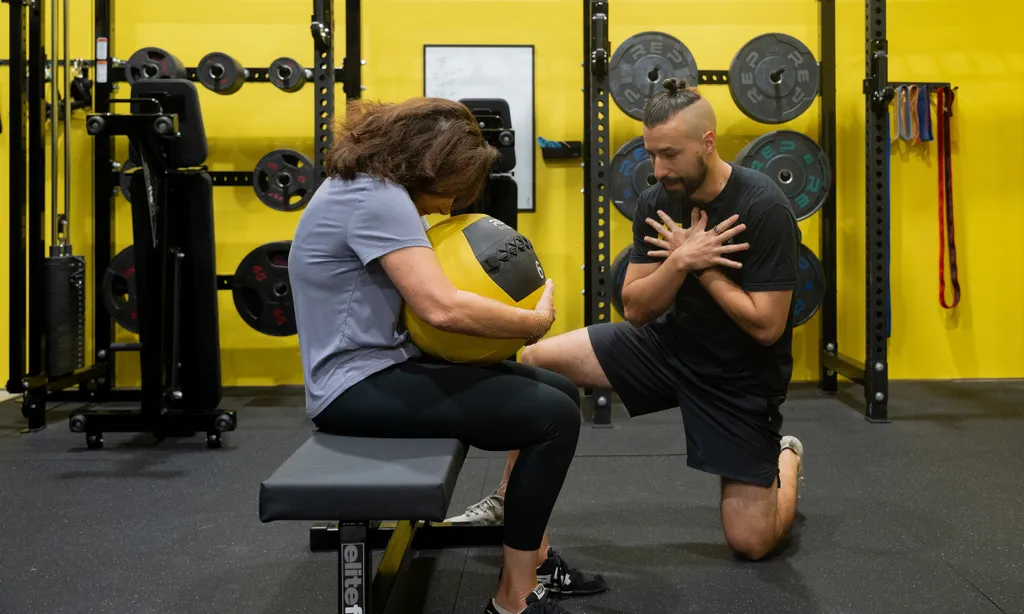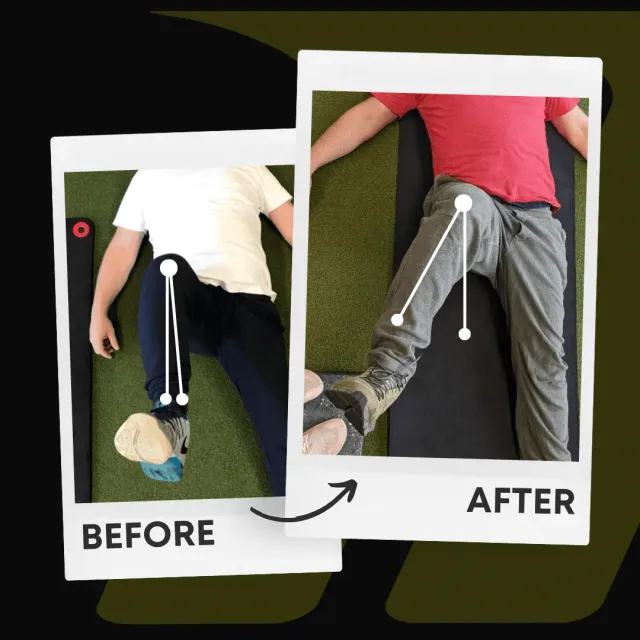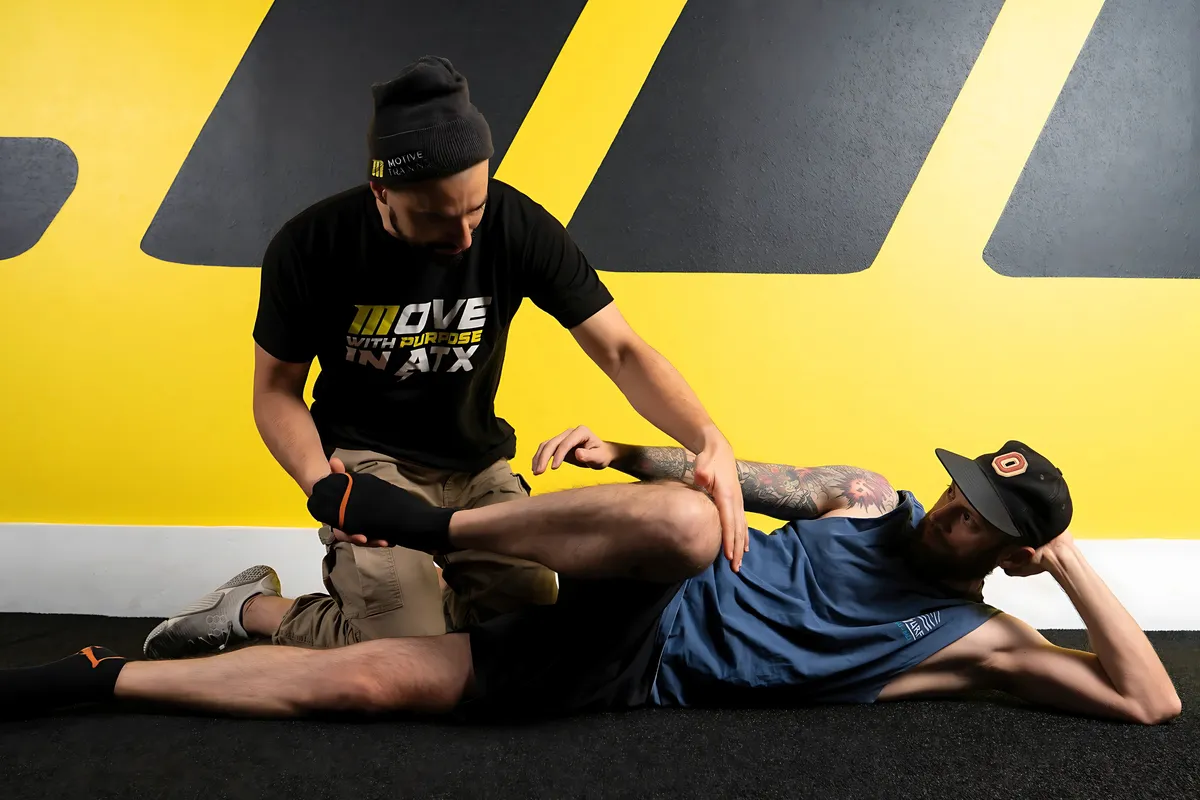Stand Tall, Austin! Enhance Your Fitness Journey With The Power Of Good Posture
October 5, 2024 | Posture

Hey Motive Fam! We see you out there, showing up day in and day out, pushing yourself to new heights at Motive Training. Whether you’re going for that personal best on deadlifts, powering through sprints, or working on your flexibility in yoga, one thing’s for sure: you’re living the #movewithpurpose life, getting stronger and more resilient every day. But did you know that bad posture could be silently undermining your progress? It can sneak into your routine and derail all your hard work, causing discomfort and even leading to injury.
Posture may seem like a small detail, but the secret sauce can elevate your fitness game to the next level. Proper posture helps you feel more powerful and aligned and is essential for a healthy spine, injury prevention, and maximizing athletic performance. It’s the foundation on which all your strength and movement is built.
At Motive Training, our philosophy is rooted in moving with purpose, which means prioritizing good posture in everything we do. So, let’s take a deep dive into what posture is, why it matters, and how you can master it to become stronger and healthier in every aspect of your life.
What Exactly Is Posture?
Posture refers to how you hold your body when actively moving (dynamic posture) and at rest (static posture). Imagine your spine as an elegant S-curve—there’s a natural inward curve in the neck and lower back, with a slight outward curve in the middle of your back. Good posture means keeping this natural alignment without adding excessive strain.
Standing posture is crucial for overall health and physical well-being. It contributes to strength, flexibility, and balance while reducing muscle pain and the risk of injury.
When your posture is in check, your body moves more efficiently, your muscles work optimally, and you reduce your risk of injury. Think of posture as the scaffolding that supports all your movements, whether crushing it in the gym or walking down the street.
Understanding Poor Posture
Poor posture isn’t just a physical issue. It’s a sneaky saboteur that can affect your mental well-being, contributing to feelings of fatigue and stress.
There are several types of poor posture to watch out for:
-
Slouching: This common culprit involves rounded shoulders and a forward head position, straining your neck and back muscles.
-
Swayback: Here, the lower back arches excessively, putting extra pressure on the muscles and joints in that area.
-
Forward Head Posture: When your head juts out in front of your shoulders, it significantly strains your neck and upper back. This is extremely common nowadays, given that most people sit and use their cell phones.
But what causes poor posture in the first place? Several factors can contribute, including:
-
Muscle Imbalances: When some muscles are stronger than others, they can pull your body out of alignment.
-
Poor Body Mechanics: Standing or sitting with poor posture or lifting heavy objects incorrectly can wreak havoc on your alignment.
-
Injuries: Past injuries can lead to muscle imbalances and poor posture.
-
Genetics: Sometimes, your genetic makeup can make you more prone to poor posture.
Understanding these factors is the first step in addressing and correcting poor posture. By being mindful of your body mechanics and working to balance your muscles, you can start to improve your posture and alleviate the associated discomfort.
Why Does Good Posture Matter?
Bad posture doesn’t just make you feel sluggish—it can hold you back in ways you might not expect. Here’s why good posture is a game changer:
-
Pain Prevention Powerhouse: Slouching can lead to muscle imbalances, chronic tension, and joint pain, especially in the neck, shoulders, and lower back. Poor posture puts unnecessary strain on your body, leading to aches and pains that can sideline your fitness goals. In contrast, good posture distributes your weight evenly, allowing your muscles and joints to work harmoniously. Think of it as your body’s way of keeping everything in balance. Specific exercises and yoga poses can improve posture and enhance physical health, strength, and flexibility.
-
Better Breathing: When you slouch, your chest compresses, limiting lung capacity and making it harder to take deep, full breaths. This restriction means you’re not getting as much oxygen to fuel your muscles during those tough workouts. Stand tall, and your lungs will have the space to expand fully, helping you power through those intense cardio sessions and strength circuits.
-
Mood Booster: Believe it or not, your posture affects your mood and energy levels. Studies have shown that good posture can lead to increased feelings of confidence, happiness, and vitality. On the flip side, poor posture is linked to feelings of stress and fatigue. Want to walk out of Motive Training feeling like a rockstar? Start by standing tall and owning your space.
-
Elevate Your Workout Performance: Good posture ensures your body is properly aligned, enhancing your form during exercises. This prevents injuries, helps you engage the right muscles, and achieves better results. Whether squatting, pressing, or rowing, posture is the key to optimizing every movement.
Meet Your Posture Powerhouse: The Core
Your core muscles—the abs, obliques, lower back, and pelvis—play a crucial role in maintaining good posture. Think of your core as the superhero suit that supports your entire body. Understanding this should empower you to strengthen your core for better posture and overall fitness, giving you a deeper knowledge of your body’s mechanics.
At Motive Training, we prioritize core strength in all our programs. Fortunately, our core exercises extend beyond the usual planks, dead bugs, or advanced moves like Pallof presses. The reason? Posture is less about creating stiffness (e.g., traditional core work) and more about creating fluid-like motion between your vertebrae. Plus, a strong core isn’t just about six-pack abs—it’s about functional strength that keeps your entire body aligned and injury-free.
So, while we understand the importance of abdominal muscles in posture and spine health, it’s not the only thing to address.
Exercises for Better Posture
Improving your posture isn’t just about standing up straight—it’s about strengthening the muscles that support your body and increasing your mobility and flexibility. Here are some exercises that can help you achieve perfect posture. By understanding the importance of these exercises, you should feel equipped and ready to take on the challenge of improving your posture.
Shoulder External Rotation:
Shoulder external rotation is one key movement for maintaining a healthy posture, especially for those who spend long hours sitting or working at a desk. This movement focuses on rotating the arm outward at the shoulder joint, helping to counteract the forward, rounded shoulder position that so many of us unconsciously adopt.
-
Why It’s Important: Poor posture often leads to internally rotated shoulders, which can cause tightness in the chest and weakness in the upper back. External rotation strengthens the rotator cuff muscles and opens the chest, leading to improved shoulder alignment and less strain on the neck and upper back.
-
Posture Benefit: Strengthening the muscles responsible for external rotation helps pull the shoulders back into alignment, improving overall posture and reducing the likelihood of slouching.
Shoulder Retraction & Depression:
This exercise is crucial for correcting the “hunched” posture that may develop due to long sitting or looking down at phones. Shoulder retraction and depression involve pulling the shoulder blades back and down, activating the muscles between the shoulder blades and the lower trapezius.
-
Why It’s Important: When we hunch forward, the muscles between the shoulder blades (the rhomboids) and lower trapezius become weak and underused while the chest muscles tighten. Strengthening these muscles helps balance the shoulders and supports proper spinal alignment.
-
Posture Benefit: Strengthening the muscles that retract and depress the shoulders helps combat rounded shoulders and maintains a neutral spine position, preventing that slouched-forward appearance.
We will release more content about shoulders soon. In the meantime, you can practice shoulder and scapular CARs to reduce muscle tension in the upper back and achieve the correct posture position.
Cervical Mobility & Retraction:
Cervical mobility and retraction focus on the neck’s ability to move freely while maintaining a healthy, aligned position. These exercises are especially important for combating the “tech neck” or “text neck” posture that results from looking down at screens all day.
-
Why It’s Important: When we habitually look down, the muscles at the back of the neck lengthen and weaken while the front neck muscles tighten. This can lead to discomfort, headaches, and a forward head posture. Cervical retraction realigns the head over the spine, relieving this strain.
-
Posture Benefit: Regular cervical retraction practice helps correct forward head posture, reduce neck strain, and promote a taller, more upright posture.
You can practice better neck flexion and retraction with this exercise:
It will also help reduce “text neck” and improve neck pain!
Thoracic Extension:
Thoracic extension exercises target the mid-back area, improving flexibility and reducing stiffness in the thoracic spine (the upper and middle portions of the back). This area often becomes tight due to slouching or spending too much time sitting.
-
Why It’s Important: Many posture issues stem from a rounded thoracic spine (kyphosis), which can restrict movement and lead to compensatory neck and lower back issues. Thoracic extension helps open up the chest and mid-back, promoting better spinal alignment.
-
Posture Benefit: Increasing thoracic mobility allows for greater spinal extension, which is essential for standing tall and keeping your chest open. This helps combat slouching and maintains a more upright posture throughout the day.
We covered thoracic extension drills on this Instagram post:
Controlled Articular Rotations (CARs):
CARs are a set of joint mobility exercises designed to move each joint through its full range of motion. When it comes to posture, CARs for the neck, shoulders, and spine are instrumental in maintaining joint health and improving mobility in areas prone to stiffness.
-
Why It’s Important: Our joints naturally lose mobility over time, especially if they’re not regularly moved through their full range of motion. CARs help lubricate the joints, prevent stiffness, and keep the body’s range of motion intact, which is crucial for maintaining good posture.
-
Posture Benefit: Regularly performing CARs keeps your joints mobile and healthy, preventing stiffness and compensatory movements that lead to poor posture. These exercises also increase body awareness, helping you recognize and correct postural imbalances before they become problematic.
By incorporating these exercises into your routine, you’ll improve your posture and enhance your mobility, strength, and overall well-being. At Motive Training, we believe in moving with purpose, and mastering these posture-improving movements is a key part of that journey!
Tips To Improve Your Posture—In and Out Of The Gym
Ready to level up your posture? Here are some simple but effective ways to keep your body aligned and pain-free, whether you’re crushing your next workout or running errands around Austin.
-
Posture Patrol: Regularly check in with yourself throughout the day. Are your shoulders rounded forward? Is your neck craned toward your phone? Stop, reset, and pull your shoulders back. Make this a habit, and you’ll gradually see improvements.
-
Ergonomic Edge: If you spend hours at a desk or in front of a screen, it’s time to evaluate your workspace. Set up an ergonomic chair, adjust your monitor to eye level, and use a standing desk. Small changes can make a big difference in maintaining good posture during work hours.
-
Stretch It Out: Stiff muscles, particularly in the hips and shoulders, can contribute to poor posture. Incorporate regular stretching or mobility work into your routine. At Motive Training, we offer plenty of mobility and flexibility programs to help you loosen tight areas and restore your range of motion. Plus, you can check out a KINSTRETCH class that will help you maintain good posture.
-
Break Up Prolonged Sitting: If you sit for long periods, your posture can suffer. Set a timer to remind yourself to stand up, move around, and stretch every hour or so. Your muscles will stay limber, and your spine will thank you.
-
Expert Advice: Our team of certified trainers at Motive Training is here to help! Don’t hesitate to ask for a posture assessment or corrective exercises to target specific issues. We’re passionate about helping you move better and feel stronger in and out of the gym.
Posture and Athletic Performance
Good posture isn’t just about looking confident—it’s a game-changer for athletic performance. When your body is properly aligned, it moves more efficiently and effectively, allowing you to perform at your best. On the flip side, poor posture can lead to a range of issues that can hinder your athletic prowess.
-
Reduced Power & Speed: Misalignment can sap your strength and slow you down, making it harder to generate the power and speed you need for peak performance.
-
Increased Risk Of Injury: Poor posture strains your muscles, joints, and ligaments, increasing the likelihood of injuries that can sideline you.
-
Reduced Endurance: Maintaining good form and technique is crucial for endurance, and poor posture can make this more challenging, leading to quicker fatigue.
So, how can athletes improve their posture? Here are some tips:
-
Engage In Core-Strengthening Exercises: Moves like planks and bridges can help build the core strength needed to support good posture.
-
Practice Good Body Mechanics: Be mindful of your standing, sitting, and moving posture. Proper technique is key.
-
Use Proper Technique When Lifting: Whether you’re lifting weights or everyday objects, using the correct form can prevent strain and injury.
-
Stretch Regularly: Flexibility is crucial for maintaining good posture. Incorporate regular stretching into your routine to keep your muscles limber.
By focusing on these areas, you can improve your posture and, in turn, elevate your athletic performance.
Common Posture Mistakes to Avoid
Even with the best intentions, it’s easy to fall into common posture mistakes that can lead to poor posture and muscle fatigue. Here are some pitfalls to watch out for and how to avoid them:
-
Slouching: Whether standing or sitting, slouching can put a lot of strain on your back and neck. Make a conscious effort to keep your shoulders back and your spine aligned.
-
Crossing Your Legs: Sitting with your legs crossed can lead to imbalances in your hips and lower back. Keep your feet flat on the floor to maintain a neutral posture.
-
Standing With Your Weight On One Leg: This habit can cause uneven strain on your hips and lower back. Distribute your weight evenly between both feet to avoid muscle fatigue.
-
Lifting Heavy Objects Incorrectly: Using poor lifting form can lead to serious injuries. Always bend at your knees and keep the object close to your body to minimize strain.
-
Not Taking Breaks: Sitting or standing in one position for too long can lead to muscle fatigue and poor posture. Take regular breaks to move around and stretch.
By being mindful of these common mistakes and making small adjustments, you can significantly improve your posture and overall well-being. Remember, maintaining good posture is a continuous effort, but the benefits are well worth it.
Unlearning Bad Habits: It’s Never Too Late
If you’ve been slouching for years, don’t worry—there’s hope! It’s never too late to correct bad posture. The key is consistency and mindfulness. You can gradually reverse poor posture and create new habits by incorporating small changes and focusing on building strength and flexibility. Remember, it’s a journey; every step you take towards better posture is a step towards a healthier, stronger you.
-
Patience Is A Virtue: Changing your posture won’t happen overnight, but with dedication, you’ll see progress. Start by setting small goals, like sitting up straight during meetings or stretching for five minutes before bed.
-
Strengthen & Stretch: Tight muscles can pull your body out of alignment, while weak muscles can’t support good posture. That’s why combining core strengthening exercises with stretches for your chest, shoulders, and hip flexors is essential. Our classes at Motive Training offer the perfect blend of both to help you rebalance your body.
The Final Rep: Let’s Stand Tall, Posture Austin Texas!
Mastering posture is more than looking poised—feeling your best and performing at your peak. Good posture helps you prevent injuries, breathe more efficiently, and stay energized. By incorporating posture-focused practices into your routine in the gym and at home, you’re setting yourself up for long-term success.
At Motive Training, we’re here to support you every step of the way. Our expert trainers are ready to help you move better, feel stronger, and live healthier. Together, we’ll stand tall, move with purpose, and crush every workout that comes our way.
So, what are you waiting for? Let’s conquer that posture, Austin!
Written by
Brian Murray, FRA, FRSC
Founder of Motive Training
We’ll teach you how to move with purpose so you can lead a healthy, strong, and pain-free life. Our headquarters are in Austin, TX, but you can work with us online by signing up for KINSTRETCH Online or digging deep into one of our Motive Mobility Blueprints.

